|
Katrin Kleemann, Rachel Carson Center “June the 9th [1783] was a day of clear weather, during which the cloud [north of the mountains] quickly rose higher and higher. In the evening a great downpour fell from it. The flow of the river Skaftá, a stream so great that at the ferry site here horses had to swim some seventy fathoms to cross it, and which ran eastward along the Síða area, now began to decrease substantially, however. On the 10th […] the river Skaftá had dried up entirely, except for the water emptying into it from local streams. […] On the 12th the weather was clear, with a wind from the south. Now the flood of lava spilled out of the canyon of the River Skaftá and poured forth with frightening speed, crashing, roaring and thundering. When the molten lava ran into wetlands or streams of water the explosions were as loud as if many cannon were fired at one time. At first this fiery flood followed the main course of the river, and then spread over the banks, and out over the older lava fields which stretch out on both sides […].” Jón Steingrímsson (1728-1791), local reverend, who wrote a diary In June 1783, the residents of Kirkjubæjarklaustur, an Icelandic village, watched as the water of their local river Skaftá vanished and, days later, was replaced by a “fiery flood” of lava. They could not have imagined that this event would have consequences halfway around the globe, all the way to eastern Africa. It suppressed the Nile’s summer floods and thereby helped cause a famine in Egypt, where agriculture depends on those floods. That summer, the 27-kilometer long Laki fissure, remotely located in the Icelandic highlands to the southwest of Vatnajökull, Europe’s largest glacier outside the Arctic, began an eight-month-long eruption. It released the largest amount of lava of any eruption in the last millennium, as well as huge quantities of sulfur dioxide, fluorine, and other gases. The consequences would be catastrophic for Iceland’s population. The eruption did not kill anyone directly, but Laki's gases, especially the fluorine, poisoned the fields and thereby killed a large percentage of Iceland's cattle, horses, and sheep. The people of Iceland, deprived of their main food source, soon suffered malnourishment and starvation. These “hardships of the mist“ - today remembered as móðuharðindin - lasted until 1785, and claimed the lives of about a fifth of Iceland's population. Some 10,000 people perished. 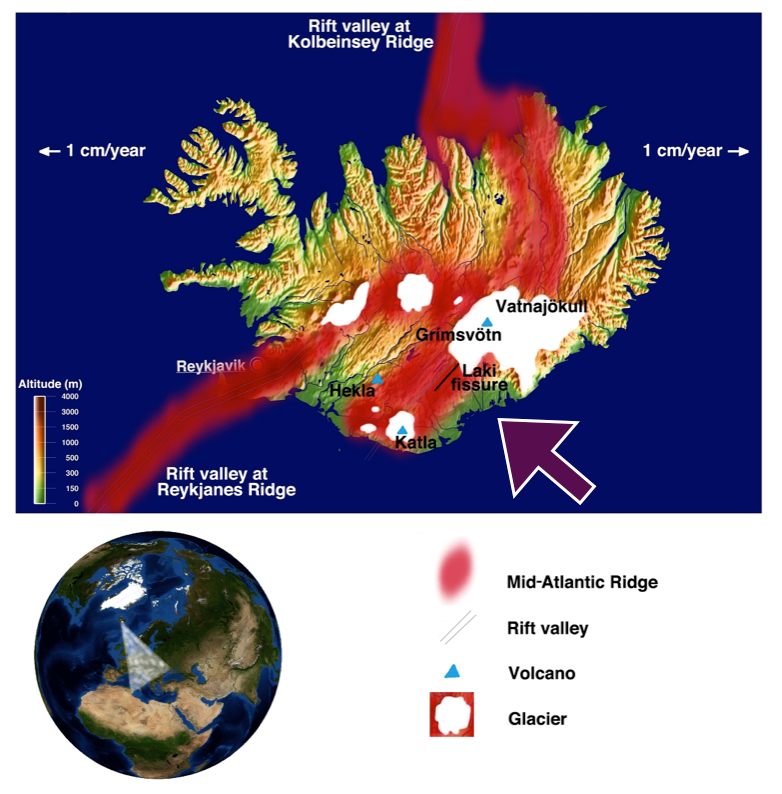 This image shows the position of Iceland and the direction in which the dry fog was blown; it also shows the position of the Mid-Atlantic Ridge and the three major volcanoes in Iceland. The Laki fissure is just southwest of the Vatnajökull ice shield. This map was created by Katrin Kleemann and is built upon map materials from Gingko Maps, which are licensed under a CC BY 3.0 license. In the rest of Europe, a strange sulfurous-smelling "dry fog" lingered for around two months. The levels of sulfur dioxide in the atmosphere were comparable to present-day extreme air pollution events. In France and England, contemporaries reported sore eyes, skin irritations, respiratory problems, and damage to vegetation. Today, this dry fog is referred to as volcanic smog, or “vog,” and we know it can worsen cardiorespiratory illnesses. Volcanologist Anja Schmidt has used climate models to simulate what would happen if a Laki-style eruption occurred today. She found that excess mortality - that is, deaths that would not have occurred otherwise - would be 142,000 deaths within a year of the eruption. In 1783, the news of a volcanic eruption in Iceland reached Europe only in September, after the fog had vanished. It took another decade for an Icelandic expedition to find the Laki fissure, and roughly one century for scientists to connect the dots between the eruption and the dry fog it caused. It would not be as long, however, before even bigger eruptions would have still more destructive consequences for human lives and livelihoods. Volcanic eruptions can cause climate change if they release large amounts of sulfur dioxide high into the stratosphere. Sulfur dioxide oxidizes into sulfuric acid aerosols, which reflect incoming solar radiation. The troposphere, which is the atmospheric layer in which we live and in which our airplanes fly, experiences cooling, whereas the stratosphere, the layer above the troposphere, which starts at 18 km near the equator and around 9-13 km in the high latitudes, heats up. Other gases released from eruptions, such as carbon dioxide, are greenhouse gases and contribute to the warming of the planet. Yet overall, big eruptions that send sulfur dioxide into the stratosphere can cause profound, if relatively short-lived, cooling. The biggest eruption in recent centuries was that of Tambora in 1815. It reached a 7 on the volcanic explosivity index (VEI), a logarithmic scale from 0 to 8 in which each level registers a tenfold increase in explosivity (measured in volume of ejecta and eruption height). By contrast, the eruption of the Laki fissure "only" reached a 4. Tambora exploded in present-day Indonesia, at a tropical latitude where trade winds - the persistent easterly winds north and south of the equator - helped to spread its aerosols around the globe. Thanks to this global dispersal, evidence of tropical volcanic eruptions can be found in Greenland and Antarctica. Glaciologists study layers of compressed snow and bubbles of preserved air in ice cores to reconstruct the climate of the past. In the cores, they also find layers of ash, tephra, and gases such as sulfur - byproducts of volcanic eruptions - which help them to date the ice layers. High latitude eruptions such as the Laki fissure eruption only deposit ash and tephra in one hemisphere. Tambora’s impact on Earth's climate was magnified as the volcano erupted in the aftermath of a very strong eruption in 1809 (VEI 6), which has not yet been localized. Both eruptions occurred in a period of low solar activity known as the Dalton Minimum (ca. 1790-1830). In 1816, Tambora therefore brought a bitterly cold "year without summer" to the Northeastern United States, as snow and frost ruined crops as late as June. Cooler temperatures and heavy rains also plagued Ireland and the rest of Europe, which helped provoke famine. Tambora also delayed the summer monsoon in India, where unseasonal and torrential rain helped cause flooding, crop failures, famine, and ultimately a cholera epidemic. The graphic also shows that several volcanic eruptions can occur at around the same time, increasing their effect on the climate and thus their impact on societies. A series of volcanic eruptions coincided with the massive 1257 Samalas eruption in today’s Indonesia, for example, and the 1458 Kuwae eruption in today’s Vanuatu. Eruptions in quick succession, including in 1595 (Nevado del Ruiz in today’s Colombia) and 1600 (Huaynaputina in today’s Peru), caused a June-July-August temperature anomaly between 1600 and 1609. In 2012, Gifford H. Miller was the lead author of an article that argued that large volcanic eruptions in the late thirteenth century might have initiated the abrupt onset of the Little Ice Age, which was then sustained for six centuries by so-called feedback loops between the ocean, sea ice, and the atmosphere. The climate system on Earth is sensitive to change and different parts of the system, solar radiation, sea ice, cloud cover, wind and ocean currents, are interconnected. One important feedback loop is the albedo effect, which relies on the fact that a white surface, such as ice, reflects more sunlight back into space than a dark surface, such as the ocean. When a series of strong eruptions at the beginning of the Little Ice Age cooled the global climate, sea ice and therefore the albedo effect increased, the Earth absorbed less solar radiation, and average global temperatures began a long and sustained decline. The resulting climatic shift was then reinforced by a series of large eruptions around 1458. Changes in solar radiation, Earth's rotation, and major patterns of oceanic and atmospheric circulation may also have contributed to the cooling, but volcanic eruptions were most to blame. The biggest concern of our present time is anthropogenic climate change and global warming. Interestingly, global warming is actually increasing the chances of volcanism in the cold parts on Earth. In many cold places, such as Iceland, there still are large ice shields, reminders of the last Ice Age, which are melting away in a warming world. The melting of these heavy ice shields takes away a weight, which causes an uplifting process of the land below, called the postglacial rebound effect. In volcanically active regions, the ice shields were resting on top of magma chambers, with the decrease of weight the magma chambers can produce more magma and grow, and thus making a volcanic eruption more likely than before. In most extreme cases, the constant melting of Iceland’s glaciers could lead to an Eyjafjallajökull 2010 size eruption every seven years. Even a large volcanic eruption and a short-term cooling, similar to the Pinatubo eruption of 1991, would not change this warming trend in the long run. New research suggests that even a Tambora style eruption in 2085 would likely not offset global warming simply because the oceans will be considerably warmer than they were in 1815. Another recent paper by lead author Ingo Bethke revises climate models by including sixty potential but fictional, large eruptions over the course of the twenty-first century. Most models actually ignore the potential of such eruptions. Yet the paper concludes that future eruptions are “unlikely to mitigate long-term anthropogenic climate change.” Today, in our warming world, there are international efforts to cut greenhouse gas emissions to tackle anthropogenic climate change. Yet some scientists are also exploring ways to alter the climate through geoengineering, in order to stop the anthropogenic warming spiraling out of control. There are two different geoengineering categories: the first involves the removal of greenhouse gases such as carbon dioxide emitted by burning fossil fuels from the atmosphere, while the second involves managing solar radiation. Schemes in this second category would initiate a process of making the planet absorb less solar radiation to offset the consequences of the large-scale fossil fuel emissions of the recent past and present. Geoengineers pursuing projects in this secondary category have been inspired by the cooling consequences of volcanic eruptions. However, the onset of the Little Ice Age, and the Nile floods that accompanied the small Icelandic eruption in 1783, both reveal the risks of such geonengineering schemes. The climate system is interconnected and incredibly sensitive to change. Reproducing the effects of a large volcanic eruption is both risky and dangerous, since we cannot know all the implications and potential consequences of such an endeavor. The long history of volcanic disasters therefore provides a warning for our warmer future. Selected Works Cited:
Bethke, Ingo, Stephen Outten, Odd Helge Otterå et al. “Potential Volcanic Impacts on Future Climate Variability.“ Nature Climate Change 7 (2017): 799-805. Cole-Dai, Jihong, David G. Ferris, Alyson L. Lanciki, et al. “Two Likely Stratospheric Volcanic Eruptions in the 1450s C. E. Found in a Bipolar, Subannually Dated 800 Year Ice Core Record.“ Journal of Geophysical Research: Atmospheres 118 (2013):7459-7466 Courtillot, Vincent. “New Evidence for Massive Pollution and Mortality in Europe in 1783-1784 may have bearing on global change and mass extinctions.” Comptes Rendus Geoscience 337 (2005): 635-637. D’Arcy Wood, Gillen. Tambora. The Eruption that Changed the World. Princeton: Princeton University Press, 2014. Fasullo, J. T., R. Tomas, S. Stevenson, et al. “The Amplifying Influence of Increased Ocean Stratification on a Future Year Without a Summer.“ Nature Communications 8 (2017). Doi: 10.1038/s41467-017-01302-z Grattan, John, M. Durand, and S. Taylor. „Illness and Elevated Human Mortality in Europe Coincident with the Laki Fissure Eruption.“ In Volcanic Degassing, edited by Clive Oppenheimer, D. M. Pyle, and J. Barclay, 401-414. London: The Geological Society of London, Special Publication 213, 2003 Grattan, John, Roland Rabartin, Stephen Self, and Thorvaldur Thordarson. “Volcanic Air Pollution and Mortality in France 1783-1784.“ Comptes Rendus Geoscience 337, no. 7 (2005): 641-651 Lavigne, Franck, Jean-Philippe Degeai, Jean-Christophe Komorowski, et al. “Source of the Great A.D. 1257 Mystery Eruption Unveiled, Samalas Volcano, Rinjani Volcanic Complex, Indonesia.“ PNAS 110, no. 42 (2013): 16742-16747. Longo, Bernadette M., W. Yang, J.B. Green, et al. “Acute Health Effects Associated With Exposure to Volcanic Air Pollution (Vog) From Increased Activity at Kilauea Volcano in 2008.” Journal of Toxicology and Environmental Health 73 (2010): 1370-1381 Manning, Joseph G., Francis Ludlow, Alexander R. Stine, et al. “Volcanic Suppression of Nile Summer Flooding Triggers Revolt and Constrains Interstate Conflict in Ancient Egypt.“ Nature Communications 8 (2017). Doi: 10.1038/s41467-017-00957-y. Miller, Gifford H., Áslaug Geirsdóttir, Yafang Zhong, et al. “Abrupt Onset of the Little Ice Age Triggered by Volcanism and Sustained by Sea-Ice/Ocean Feedbacks.“ Geophysical Research Letters 39 (2012). Doi:10.1029/2011GL050168 Robock, Alan. “Pinatubo Eruption: The Climatic Aftermath.“ Science 295 (2002):1242-1244. Robock, Alan, “The Latest on Volcanic Eruptions and Climate.“ EOS Trans. AGU 94, no. 35 (2013): 305. Schmidt, Anja, Bart Ostro, Kenneth S. Carslaw, et al.: “Excess Mortality in Europe Following a Future Laki-Style Icelandic Eruption.“ PNAS 108, no. 38 (2011) :15710–15715 Schmidt, P., B. Lund, C. Hieronymous, et al. “Effects of Present-Day Deglaciation in Iceland on Mantle Melt Production Rates.“ Journal of Geophysical Research Solid Earth 118 (2013) :3366-3379. Sigl, Michael, M. Winstrup, J. R. McConnell, et al. "Timing and Climate Forcing of Volcanic Eruptions for the Past 2,500 Years.“ Nature 523 (2015): 543-549 Sigl, Michael, and Matthew Toohey. ”Volcanic Stratospheric Sulfur Injections and Aerosol Optical Depth From 500 BCE to 1900 CE.” Earth Syst. Sci. Data 9 (2017): 809-831. Steingrímsson, Jón. Fires of the Earth. The Laki Eruption 1783-1784, translated by Keneva Kunz, 25-26. Reykjavík: University of Iceland Press and Nordic Volcanological Institute, 1998. |
Archives
March 2022
Categories
All
|

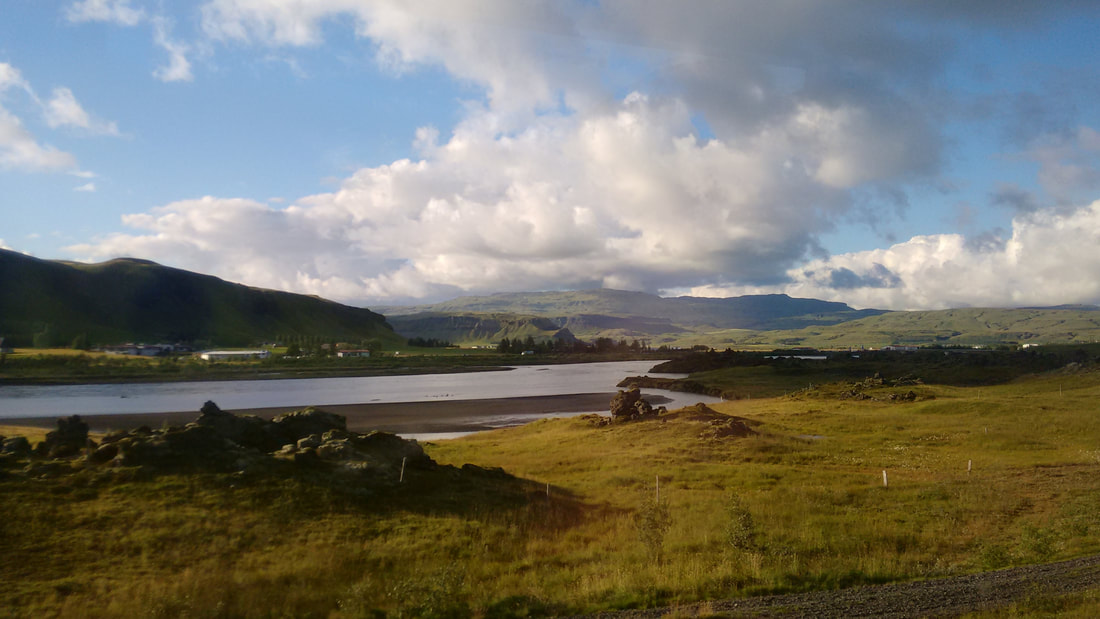
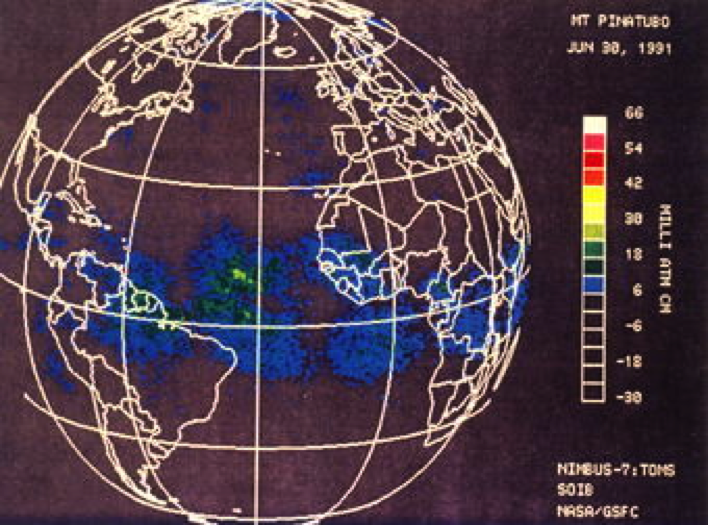

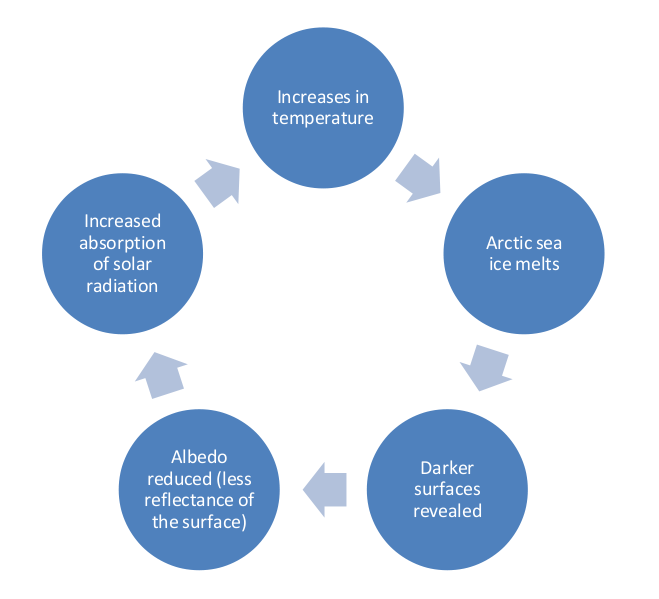
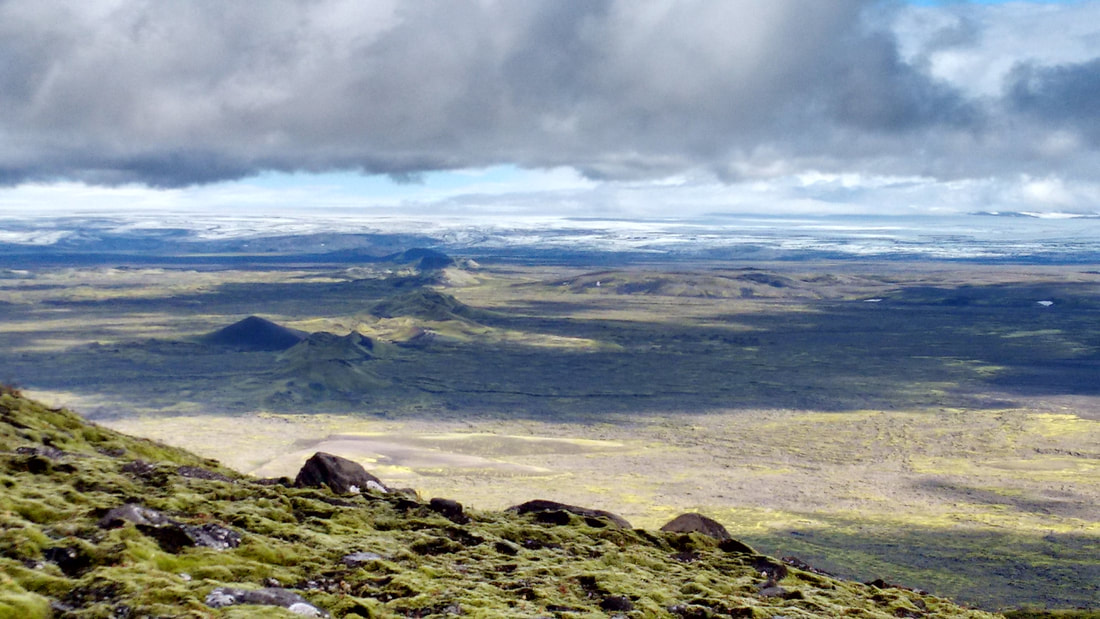
 RSS Feed
RSS Feed